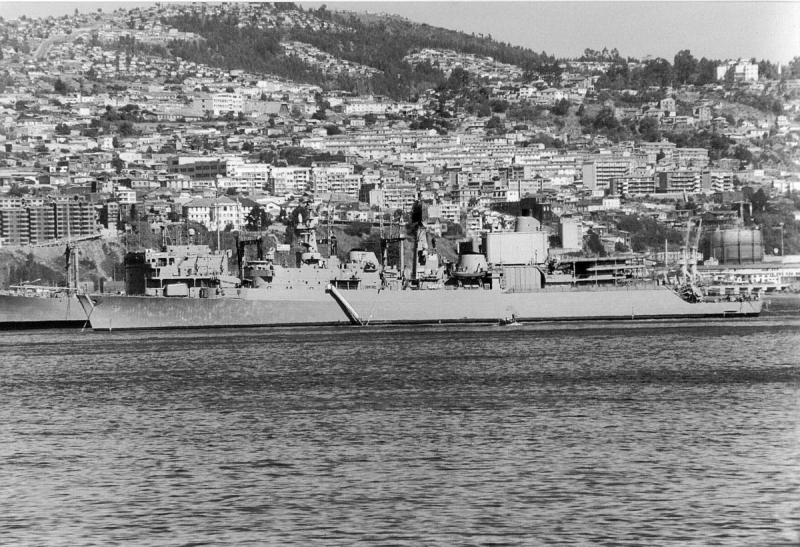Enregistrez-vous
ARMATEURS PASSES
ARMATEURS PRESENTS
NAVIRES MARCHANDS
NAVIRES MILITAIRES
OFF-SHORE
AUTRES IMAGES

| Précedente Suivante |
 |
| almirante Latorre |
| History United Kingdom Name: HMS Glamorgan Builder: Vickers-Armstrongs Laid down: 13 September 1962 Launched: 9 July 1964 Commissioned: 14 October 1966 Decommissioned: 1986 Motto: ? I Fyny Bo'r Nod ? (Welsh: "I Give Way To None") Fate: Sold to Chile in September 1986 Chile Name: Almirante Latorre Acquired: September 1986 Commissioned: 1986 Decommissioned: 1998 Fate: Sunk at sea on 11 April 2005 on way to breakers General characteristics Class and type: County-class destroyer Displacement: 6,200 tonnes (6,100 long tons) (full load) Length: 520 ft (160 m) Beam: 53 ft (16 m) Draught: 20 ft 5 in (6.22 m) Propulsion: COSAG (Combined steam and gas), two sets of geared steam turbines producing 30,000 shp (22,000 kW), 2 shafts Speed: 30 knots (56 km/h) (maximum) Range: 4,000 nautical miles (7,400 km) at 28 knots (52 km/h) Capacity: 471 Armament: ? 2? Fore-mounted twin-gunned turret with 4.5-inch (114 mm) guns Mark N6 ? 4? MM40 Exocet missile launchers replacing turret "B" (since 1975)[1] ? 2? mountings for Oerlikon 20 mm cannon ? 1? Aft-mounted Seaslug GWS.2 SAM (24 missiles) ? 2? mountings (port & starboard) for Seacat GWS-22 SAM (In Chilean service, the Seacat was replaced by 2? 8-cell VLS for Barak SAM) ? 2? triple-tube launchers for shipborne torpedoes Aircraft carried: 1? Wessex HAS Mk 3 helicopter Aviation facilities: Flight deck and enclosed hangar for embarking one helicopter HMS Glamorgan was a County-class destroyer of the Royal Navy with a displacement of 5,440 tonnes. The ship was built by Vickers-Armstrongs in Newcastle Upon Tyne and named after the Welsh county of Glamorgan. She was launched on 9 July 1964, and was delivered to the Royal Navy two years later. in 1974, she was the subject of a refit, when 'B' turret was replaced by four Exocet launchers in attempt to provide the Royal Navy reduced to one strike carrier, HMS Ark Royal with some surface fighting capability beyond the range of 4.5/6 inch guns. A much more expensive update costing 63 million pounds, fitted Glamorgan in 1977-1980 with a computerised C3 ADWAS system well in advance of its original fitting, but limited by the essential manual nature of the 4.5 turret and the ageing Seacat and Seaslug missiles. In the spring and early summer of 1982 Glamorgan was involved in the Falklands War during which she engaged Argentine land forces and protected shipping. In the last days of the war Argentine navy technicians fired a land-based MM-38 Exocet missile which struck the ship causing damage and killing 14 sailors. She was refitted in late 1982. Her last active deployment for the Royal Navy was to the coast of Lebanon in 1984. In 1986 she was sold to the Chilean Navy, and renamed Almirante Latorre. She served for 12 years until late 1998. On 11 April 2005, she sank while under tow to be broken up. Falklands campaign At the start of the Falklands campaign, on 2 April 1982, Glamorgan was already at sea off Gibraltar about to take part in exercises; she was immediately diverted to join the main Royal Navy task force, and served as flagship for Admiral Sandy Woodward during the voyage south until 15 April, when he transferred his flag to the aircraft carrier HMS Hermes. Her most useful armament proved to be her remaining twin 4.5-inch (114 mm) guns, which were used primarily to shell enemy positions on shore. Glamorgan was first in action on the evening and night of 1 May when she joined forces with the frigates HMS Arrow and HMS Alacrity to bombard Argentine positions around Stanley. The three British ships soon came under attack by three IAI Dagger jets; two 500 lb (230 kg) bombs fell close alongside Glamorgan, causing minor underwater damage. Two weeks later on 14 May she was again in action, this time supporting British special forces during the Raid on Pebble Island in the west of the Falklands. For the next two weeks until the end of May she was almost continuously engaged bombarding various shore positions on the east of the islands mainly as part of a plan to distract attention from the landings at San Carlos Water, but also against the airfield at Stanley and in support of British forces ashore. She also fired a Sea slug missile at the airstrip. At the beginning of June, the task force having been reinforced with other ships, Glamorgan was detached to protect shipping in the Towing, Repair and Logistics Area (TRALA), some 200 miles (320 km) away from the islands, but as the campaign reached a climax she was recalled in the evening of 11 June to support the Royal Marines fighting the Battle of Two Sisters. At 06:37 the following morning, Saturday 12 June 1982, Glamorgan was attacked with an MM38 Exocet missile which was fired from an improvised shore-based launcher. The two MM38 Exocet missiles had been removed from the destroyer ARA Segu? and secured on the launcher, a technically difficult task requiring reprogamming.[13] The launcher was dubbed 'ITB' (Instalaci?n de Tiro Berreta) by the Argentine personnel which approximately means in Argentine slang "trashy firing platform". Two MM38 Exocet missiles, their launcher, transporter, and the associated electronics trailer were assembled by the Argentine navy at Puerto Belgrano and flown by a C-130 Hercules transport aircraft to the Falkland Islands. A RASIT radar supplied by the Argentinian Army tracked Glamorgan's movements. Glamorgan was steaming at about 20 knots (37 km/h) some 18 nautical miles (33 km) off shore. The first attempt to fire a missile did not result in a launch. At the second attempt a missile was launched, but it did not find the target. The third attempt resulted in a missile tracking the target. The incoming Exocet missile was being tracked on both the bridge and operations room radar by the Principal Warfare Officer and Navigation Officer. Before the missile impact, the ship was moving at high speed. After the ship executed a rapid turn away from the missile in the limited time available, a few seconds, the Exocet struck the port side adjacent to the hangar near the stern. The turn had prevented the missile from striking the ship's side perpendicularly and penetrating; instead it hit the deck coaming at an angle, near the port Seacat launcher, skidded on the deck, and exploded. This made a 10 by 15 feet (3.0 m ? 4.6 m) hole in the hangar deck and a 5 by 4 feet (1.5 m ? 1.2 m) hole in the galley area below, where a fire started. The blast travelled forwards and down, and the missile body, still travelling forwards, penetrated the hangar door, causing the ship's fully fuelled and armed Wessex helicopter (HAS.3 XM837) to explode and start a severe fire in the hangar. Fourteen crew members were killed and more wounded. The ship was under way again with all fires extinguished by 10:00. On the following day, repairs were made at sea and, after the Argentinian surrender on 14 June, more extensive repairs were undertaken in the sheltered bay of San Carlos Water. She sailed for home on 21 June, and re-entered Portsmouth on 10 July 1982 after 104 days at sea. Crew killed in the Falklands War The following crew members were killed in action during the Falklands War.[16][17] ? Petty Officer Air Engineering Mechanic Michael J. Adcock ? Cook Brian Easton ? Air Engineering Mechanic Mark Henderson ? Air Engineering Mechanic Brian P. Hinge ? Acting Charge Chief Air Engineering Mechanician David Lee ? Cook Brian J. Malcolm ? Petty Officer Air Engineering Artificer Kelvin I. McCallum ? Able Seaman David McCann ? Marine Engineering Mechanic Terence W. Perkins ? Leading Cook Mark A. Sambles ? Leading Cook Anthony E. Sillence ? Steward John D. Stroud ? Lieutenant David H. R. Tinker ? Petty Officer Aircrewman Colin P. Vickers After the Falklands campaign HMS Glamorgan spent many months in late 1982 being refitted, and was back at sea in 1983. Her last active deployment for the Royal Navy was to the coast of Lebanon, assisting British peace-keeping troops there in 1984. She was decommissioned by the Royal Navy in 1986, sold to the Chilean Navy, and renamed Almirante Latorre. In 1996, 40/70 mm was replaced with the Barak SAM. She served for 12 years until she was decommissioned again in late 1998. On 11 April 2005, she sank in the South Pacific while under tow to be broken up. A Memorial was erected in 2011 in memory of the ship and the lost crew at Hookers Point outside Stanley. Commanding Officers From To Captain August 1966 May 1968 Captain Richard E Roe RN May 1968 December 1968 Captain Ronald C.C. Greenlees RN December 1968 March 1970 Captain Stanley L. McArdle RN March 1970 October 1971 Captain Raymond P Dannreuther RN October 1971 1973 Captain Thomas Baird RN June 1976 August 1977 Captain B K Shattock ADC RN 1977 1980 Refit 1978 1979 Commander M Cribb RN 1979 1982 Captain M E Barrow RN, DSO |
| Username | |
| Armateur | Chilean Navy |
| Ship manager | |
| Numéro IMO | |
| Type de navire | Destroyer |
| Année et chantier de construction | 1966 Vickers-Armstrongs |
| Date | |
| Lieu | |
| Téléchargée le | 24/02/2017 |
| Dimension | 1200 x 820 |
| visites | 1581 |















